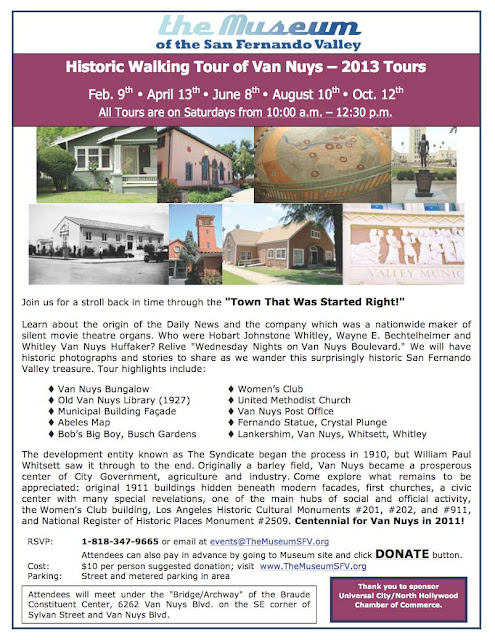Today, after several years of making promises to myself, I have begun my second walking journey along Ventura Boulevard through the San Fernando Valley. This year, to honor The Museum of the San Fernando Valley's inclusion of Hidden Hills as one of the communities we serve, I thought I would start at the historic Boething Treeland Nursery just at the entrance of gated Hidden Hills.
The entrance to Hidden Hills - 2013 (click on image to enlarge it)
Until
we surrendered and bought an artificial Christmas tree, for several years my wife Janne and I purchased living trees from Treeland - that is, until our Tarzana
home began to look at lot like Washington State. So it was a good omen that my walk's beginning should be at the classic old
nursery.
Walking through ferns and sago palms for me has always triggered fantasies of Jurassic Park. I always expect, even though its the wrong geologic era, to see sabre tooth cats and other fierce creatures peeking through the bamboo. The creatures below were as close as I got at Treeland.
Saber tooth tiger on the back of a nursery delivery truck.
Saber tooth cats (not tigers) once roamed the marshy edges of the Los Angeles River and the banks of an unpredictable Toluca Lake. Since the Valley had no tar pits, those really scary prehistoric creatures left their fossils inconveniently downtown, for the Page Museum to display. (Just kidding, the Page Museum is absolutely terrific!)
Treeland is not a safe place for rodents or unwise birds, as this well fed and "fearsome" nursery cat proves.
On the south east section of Treeland Nursery, you can view Calabasas Creek, one of the two waterways that form the Los Angeles River in Canoga Park.
Perhaps, as the old time humorist and singer Tennessee Ernie Ford liked to say, "Iffen the good Lord's willen, and the creek (pronounced "crick") don't rise..." I'll show you, one day soon, the spot in Calabasas where this stream makes its dramatic appearance.
"Por favor, no riegue los cactus y suculentas." Please don't water the cactus or succulents. There are gentle reminders at Treeland that our native plants in the San Fernando Valley have their own rules for propagation.
"5 Miles an Hour - Dust Damages Plant Material." "Women Employee Parking Only"
The hills of Calabasas mark the western most parts of the San Fernando Valley. The horned toads and scorpions that once made this area home are all but gone. Only an occasional lizard or rattle snake reminds us of the days before water was imported from the Sierras.
Huge piles of mulch await their use for the plants of Treeland Nursery. Peeking over the 20 foot high mounds is the first street sign in the San Fernando Valley that marks the beginning of my walking adventure. Onward now, "Ad Ventura"
Please support our efforts to bring about a great Museum of history and culture for the greater San Fernando Valley.
The Museum of the San Fernando Valley
21031 Ventura Blvd., Suite 419
Woodland Hills, CA 91364-2230
THE MUSEUM’S TELEPHONE
1 (818) 347-9665
THE MUSEUM'S EMAILS
gerald.fecht@TheMuseumSFV.org
info@TheMuseumSFV.org
THE MUSEUM’S BLOG
THE MUSEUM’S WEBSITE
www.TheMuseumSFV.org
















































